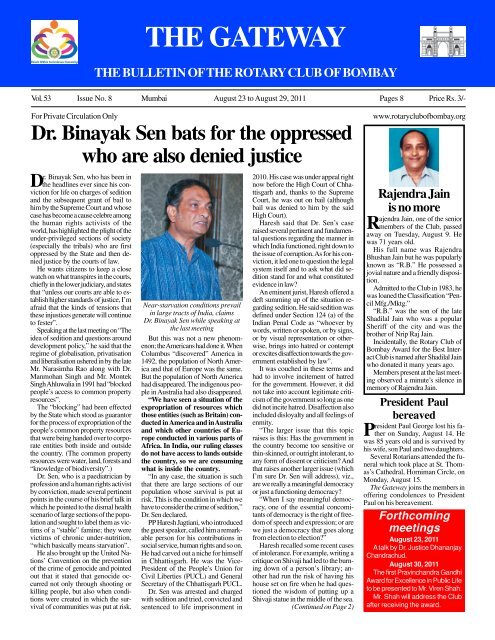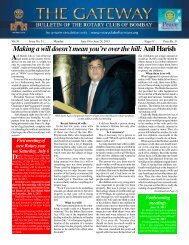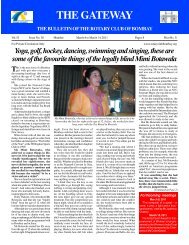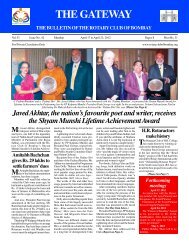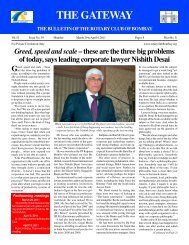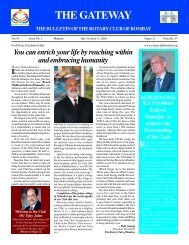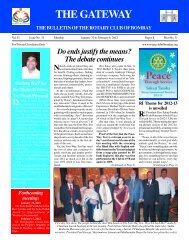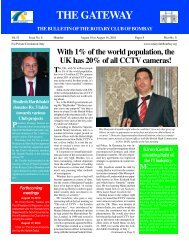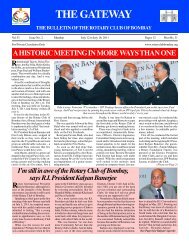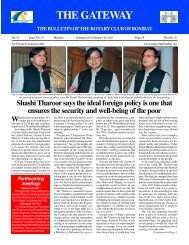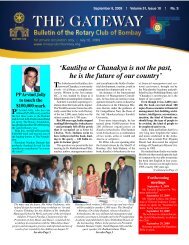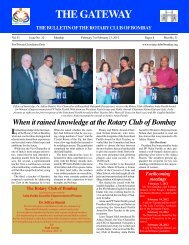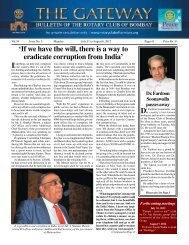Gateway 230811.pmd - Rotary Club of Bombay
Gateway 230811.pmd - Rotary Club of Bombay
Gateway 230811.pmd - Rotary Club of Bombay
You also want an ePaper? Increase the reach of your titles
YUMPU automatically turns print PDFs into web optimized ePapers that Google loves.
THE GATEWAYTHE BULLETIN OF THE ROTARY CLUB OF BOMBAYVol. 53 Issue No. 8 Mumbai August 23 to August 29, 2011 Pages 8 Price Rs. 3/-For Private Circulation OnlyDr. Binayak Sen bats for the oppressedwho are also denied justiceDr. Binayak Sen, who has been inthe headlines ever since his convictionfor life on charges <strong>of</strong> seditionand the subsequent grant <strong>of</strong> bail tohim by the Supreme Court and whosecase has become a cause celebre amongthe human rights activists <strong>of</strong> theworld, has highlighted the plight <strong>of</strong> theunder-privileged sections <strong>of</strong> society(especially the tribals) who are firstoppressed by the State and then deniedjustice by the courts <strong>of</strong> law.He wants citizens to keep a closewatch on what transpires in the courts,chiefly in the lower judiciary, and statesthat “unless our courts are able to establishhigher standards <strong>of</strong> justice, I’mafraid that the kinds <strong>of</strong> tensions thatthese injustices generate will continueto fester”.Speaking at the last meeting on “Theidea <strong>of</strong> sedition and questions arounddevelopment policy,” he said that theregime <strong>of</strong> globalisation, privatisationand liberalisation ushered in by the lateMr. Narasimha Rao along with Dr.Manmohan Singh and Mr. MontekSingh Ahluwalia in 1991 had “blockedpeople’s access to common propertyresources”.The “blocking” had been effectedby the State which stood as guarantorfor the process <strong>of</strong> expropriation <strong>of</strong> thepeople’s common property resourcesthat were being handed over to corporateentities both inside and outsidethe country. (The common propertyresources were water, land, forests and“knowledge <strong>of</strong> biodiversity”.)Dr. Sen, who is a paediatrician bypr<strong>of</strong>ession and a human rights activistby conviction, made several pertinentpoints in the course <strong>of</strong> his brief talk inwhich he pointed to the dismal healthscenario <strong>of</strong> large sections <strong>of</strong> the populationand sought to label them as victims<strong>of</strong> a “stable” famine; they werevictims <strong>of</strong> chronic under-nutrition,“which basically means starvation”.He also brought up the United Nations’Convention on the prevention<strong>of</strong> the crime <strong>of</strong> genocide and pointedout that it stated that genocide occurrednot only through shooting orkilling people, but also when conditionswere created in which the survival<strong>of</strong> communities was put at risk.Near-starvation conditions prevailin large tracts <strong>of</strong> India, claimsDr. Binayak Sen while speaking atthe last meetingBut this was not a new phenomenon;the Americans had done it. WhenColumbus “discovered” America in1492, the population <strong>of</strong> North Americaand that <strong>of</strong> Europe was the same.But the population <strong>of</strong> North Americahad disappeared. The indigenous peoplein Australia had also disappeared.“We have seen a situation <strong>of</strong> theexpropriation <strong>of</strong> resources whichthose entities (such as Britain) conductedin America and in Australiaand which other countries <strong>of</strong> Europeconducted in various parts <strong>of</strong>Africa. In India, our ruling classesdo not have access to lands outsidethe country, so we are consumingwhat is inside the country.“In any case, the situation is suchthat there are large sections <strong>of</strong> ourpopulation whose survival is put atrisk. This is the condition in which wehave to consider the crime <strong>of</strong> sedition,”Dr. Sen declared.PP Haresh Jagtiani, who introducedthe guest speaker, called him a remarkableperson for his contributions insocial service, human rights and so on.He had carved out a niche for himselfin Chhattisgarh. He was the Vice-President <strong>of</strong> the People’s Union forCivil Liberties (PUCL) and GeneralSecretary <strong>of</strong> the Chhattisgarh PUCL.Dr. Sen was arrested and chargedwith sedition and tried, convicted andsentenced to life imprisonment in2010. His case was under appeal rightnow before the High Court <strong>of</strong> Chhattisgarhand, thanks to the SupremeCourt, he was out on bail (althoughbail was denied to him by the saidHigh Court).Haresh said that Dr. Sen’s caseraised several pertinent and fundamentalquestions regarding the manner inwhich India functioned, right down tothe issue <strong>of</strong> corruption. As for his conviction,it led one to question the legalsystem itself and to ask what did seditionstand for and what constitutedevidence in law?An eminent jurist, Haresh <strong>of</strong>fered adeft summing up <strong>of</strong> the situation regardingsedition. He said sedition wasdefined under Section 124 (a) <strong>of</strong> theIndian Penal Code as “whoever bywords, written or spoken, or by signs,or by visual representation or otherwise,brings into hatred or contemptor excites disaffection towards the governmentestablished by law”.It was couched in these terms andhad to involve incitement <strong>of</strong> hatredfor the government. However, it didnot take into account legitimate criticism<strong>of</strong> the government so long as onedid not incite hatred. Disaffection alsoincluded disloyalty and all feelings <strong>of</strong>enmity.“The larger issue that this topicraises is this: Has the government inthe country become too sensitive orthin-skinned, or outright intolerant, toany form <strong>of</strong> dissent or criticism? Andthat raises another larger issue (whichI’m sure Dr. Sen will address), viz.,are we really a meaningful democracyor just a functioning democracy?“When I say meaningful democracy,one <strong>of</strong> the essential concomitants<strong>of</strong> democracy is the right <strong>of</strong> freedom<strong>of</strong> speech and expression; or arewe just a democracy that goes alongfrom election to election?”Haresh recalled some recent cases<strong>of</strong> intolerance. For example, writing acritique on Shivaji had led to the burningdown <strong>of</strong> a person’s library; anotherhad run the risk <strong>of</strong> having hishouse set on fire when he had questionedthe wisdom <strong>of</strong> putting up aShivaji statue in the middle <strong>of</strong> the sea.(Continued on Page 2)www.rotaryclub<strong>of</strong>bombay.orgRajendra Jainis no moreRajendra Jain, one <strong>of</strong> the seniormembers <strong>of</strong> the <strong>Club</strong>, passedaway on Tuesday, August 9. Hewas 71 years old.His full name was RajendraBhushan Jain but he was popularlyknown as “R.B.” He possessed ajovial nature and a friendly disposition.Admitted to the <strong>Club</strong> in 1983, hewas loaned the Classification “PencilMfg./Mktg.”“R.B.” was the son <strong>of</strong> the lateShadilal Jain who was a popularSheriff <strong>of</strong> the city and was thebrother <strong>of</strong> Nrip Raj Jain.Incidentally, the <strong>Rotary</strong> <strong>Club</strong> <strong>of</strong><strong>Bombay</strong> Award for the Best Interact<strong>Club</strong> is named after Shadilal Jainwho donated it many years ago.Members present at the last meetingobserved a minute’s silence inmemory <strong>of</strong> Rajendra Jain.President PaulbereavedPresident Paul George lost his fatheron Sunday, August 14. Hewas 85 years old and is survived byhis wife, son Paul and two daughters.Several Rotarians attended the funeralwhich took place at St. Thomas’sCathedral, Horniman Circle, onMonday, August 15.The <strong>Gateway</strong> joins the members in<strong>of</strong>fering condolences to PresidentPaul on his bereavement.ForthcomingmeetingsAugust 23, 2011A talk by Dr. Justice DhananjayChandrachud.August 30, 2011The first Pravinchandra GandhiAward for Excellence in Public Lifeto be presented to Mr. Viren Shah.Mr. Shah will address the <strong>Club</strong>after receiving the award.
‘37% <strong>of</strong> India’s total adult population suffers from chronicunder-nutrition (which means starvation)’(Continued from Page 1)And if one decided to make a filmon Sonia Gandhi, one would have topass the Congress Party’s “censorboard” because it had to know whatexactly the film was going to state.Films that touched on sensitive issueshad been banned time and again.“Of course, right now we haveseen it happening since morning(on Tuesday, August 16), with thearrest <strong>of</strong> Anna Hazare. All that hewanted to do was to lodge a protestand exercise a non-violent protest...but the government tells him, orrather the police tells him, that youcan only fast for three days. Forheaven’s sake, he’s not going on adiet! He’s going on a fast!“These are issues which I am sureDr. Sen will touch upon and I thoughtit might be pertinent in that sense tocircumscribe my thoughts,” Hareshadded.The following is the text <strong>of</strong> the addressdelivered by Dr. Binayak Sen:I am grateful to the Rotarians forgiving me this opportunity to speakon issues that have become central toour political life. I will speak aboutsedition and the role <strong>of</strong> dissent in democracy,but before that I would liketo address certain other issues which,in my view, are anterior to the wholeargument about sedition.I will talk about the “stable” faminethat exists over much <strong>of</strong> our land, abouthow people are able to negotiate thatfamine through their access to commonproperty resources. I will alsotell you how the common propertyresources which enable large sections<strong>of</strong> our population to negotiate the famineare being taken away from them.Common property resources arebeing taken away through State actionwhich may be peaceful if that isenough; but when that is not enough,they are taken away by armed actionby the State. Further, the laws relatingto sedition, which are outdated lawsto begin with, are being used by theState to suppress the resistance toexpropriation <strong>of</strong> common propertyresources that are essential for the survival<strong>of</strong> these communities.I will start with the famine in largeparts <strong>of</strong> the country. Let us take thedata <strong>of</strong> the National Nutrition MonitoringBureau (NNMB) which is part<strong>of</strong> the National Institute <strong>of</strong> Nutritionand is a government organisation headquarteredin Hyderabad. The NNMBconducts serial surveys <strong>of</strong> nutritionalstatus over large parts <strong>of</strong> the country.The latest available data tells us aboutthe BMI (Body Mass Index) which,as you probably know, is an index thatgives a rapid and robust indicator <strong>of</strong>the nutritional status both at the individualas well as at the communitylevel.BMI is weight in kilograms dividedby height in metres, squared. Myweight is 80 kg. and my height is 1.75metres. Thus, 80 divided by 1.75 andsquared will give my BMI (which islarger than it should be). The normalBMI is between 18.5 and 22 or 23. ABMI below 18.5 is regarded as an indicator<strong>of</strong> chronic under-nutrition –which basically means starvation.In our country, 37% <strong>of</strong> the totaladult population has a BMI below18.5. If you disaggregate this figure,you will find that among the scheduledtribes 50% have a BMI below18.5 and 60% <strong>of</strong> scheduled castes havea BMI below 18.5. As per the SacharCommittee data, large sections <strong>of</strong> theminorities have a BMI below 18.5.And we are not even consideringchildren. As a paediatrician I am especiallyconcerned about children; 47%<strong>of</strong> all children below the age <strong>of</strong> 5 areunder-nourished by weight for age criteria.Going by low birth-weight data,any baby weighing less than 2.5 kg. isregarded as being <strong>of</strong> low birth weight.Sadly, 23 to 25% <strong>of</strong> all our new-bornbabies weigh less than 2.5 kg.The new Barker’s hypothesis demonstratesthat babies with a low birthweight go on to become early diabetics;they get ischemic heart disease;they can have the entire metabolicsyndrome, including ischemic heartdisease and diabetes mellitus, chronicbronchitis and so forth.Leaving aside the fact that 47% <strong>of</strong>the children below 5 years in the countrywere under-weight and looking atonly the adults... the World HealthOrganisation (WHO) says that anycommunity in which over 40% <strong>of</strong> themembers have a BMI below 18.5 is acommunity that can legitimately beregarded as a community in famine.Large sections <strong>of</strong> our populationsuffer from a ‘stable’ famine; theyare in a continuous state <strong>of</strong> famine,says Dr. Binayak SenIf we take this criterion and applyit to the National Nutrition MonitoringBoard data, we find that there arelarge sections <strong>of</strong> our population whichare suffering from a stable famine andthat they are in a continuous state <strong>of</strong>famine. Thus this is a “stable” (permanent)famine.But it’s not only that we have astable famine; let’s look at the data setforth by Ms Utsa Pattnaik, an economistworking on agriculture-relatedissues at the Jawaharlal Nehru University.She looked at serial data ongrain consumption and found that grainconsumption had been declining.In an average family <strong>of</strong> five, the annualgrain consumption ten years agowas 880 kg.; now it has come down to770 kg. Actually, these are average figures,so the grain consumption at thetop end <strong>of</strong> the scale has actually goneup not because people are eating moregrains, but because they are consumingmore grain in the form <strong>of</strong> wheat.Thus, actually the decline at the lowerend <strong>of</strong> the scale is more than the 110kg. per year that the average datashows.In this kind <strong>of</strong> scenario, how dothese people survive, how do thesecommunities survive? Our experiencewith organisations working amongtribal people and the experience <strong>of</strong>others working in rural and urban settingsshows that these communitieshave survived because <strong>of</strong> their accessto common property resources (suchas water, land, forests and knowledge<strong>of</strong> biodiversity).But since 1991, with the globalisation,privatisation and liberalisationregime ushered in by the late Mr. P.V.Narasimha Rao, Dr. Manmohan Singhand Mr. Montek Singh Ahluwalia andtheir ilk, we have a situation in whichthese people’s access to common propertyresources is being blocked. It isbeing blocked by a State that standsas guarantor for the process <strong>of</strong> expropriationin which these people’s accessto common property resourcesis taken away from them and handedover to corporate entities, both insideand outside our country. This is thesituation we are confronting.Next, I would like to bring up theUN Convention on the prevention <strong>of</strong>the crime <strong>of</strong> genocide; this says thatgenocide doesn’t occur only throughshooting or killing people with bullets.Genocide also occurs when conditionsare created in which the survival<strong>of</strong> communities is put at risk. Iwould submit to you to please examinethe moral hazard <strong>of</strong> the situation inwhich we are placed today, in whichwe are creating certain conditions...This is not a new phenomenon inworld history; the Americans havedone it before. When Columbus “discovered”America in 1492, the population<strong>of</strong> North America and the population<strong>of</strong> Europe was the same. Thepopulation <strong>of</strong> North America has disappeared.The indigenous people inAustralia have disappeared.We have seen the expropriation <strong>of</strong>resources which those entities (suchas Britain) conducted in America andin Australia and which other countries<strong>of</strong> Europe conducted in various parts<strong>of</strong> Africa. In India, our ruling classesdo not have access to lands outsidethe country, so we are consuming whatis inside the country. In any case, thesituation is such that there are largesections <strong>of</strong> our population whose survivalis put at risk.This is the condition in which wehave to consider the crime <strong>of</strong> sedition.I’m very proud to say that I havebeen convicted <strong>of</strong> the crime <strong>of</strong> sedition.Others who have been convictedinclude Mahatma Gandhi andLokmanya Tilak. Tilak was chargedthree times, the Mahatma twice. MahatmaGandhi pleaded guilty to thecrime <strong>of</strong> sedition; he said I do not holdthe British government in any affection,so it is my duty to tell the citizens<strong>of</strong> my country that I do not holdthis government in any affection. TheBritish judge who was trying MahatmaGandhi said he had been given an oneroustask but, given the nature <strong>of</strong> thelaw, he could do nothing but convicthim. Mahatma Gandhi was convictedto six years in prison; <strong>of</strong> course, hewas released after spending two yearsin prison.I do not wish to imply that I amcomparable to Mahatma Gandhi inany sense or form, but I would like totell you that the Indian judge who adjudgedmy case, not only did he notfeel the need to distance himself fromthe sentence that he was pronouncing,he also pronounced life imprisonmenton the charge <strong>of</strong> sedition againstme even though I had pleaded notguilty to the charge.The important thing that I wish tobring before you is not about my trial.The charge <strong>of</strong> sedition against me isnot the important thing.What I wish to bring to your noticeis that the communities forwhom resistance to the process <strong>of</strong>expropriation has become a necessityin order to stay alive, it is tosuppress those communities thatthe laws <strong>of</strong> sedition, Section 124<strong>of</strong> the Indian Penal Code and similarlegal provisions in other actsare being used. They are beingused to suppress dissent and resistanceto expropriation acrossour land.(Continued on Page 6)August 23 to August 29, 2011 THE GATEWAY, The Bulletin <strong>of</strong> the <strong>Rotary</strong> <strong>Club</strong> <strong>of</strong> <strong>Bombay</strong> Page 2
Dr. Justice Chandrachud has served asAdditional Solicitor General <strong>of</strong> IndiaDr. Justice Dhananjaya Y.Chandrachud, judge <strong>of</strong> the<strong>Bombay</strong> High Court, who will addressthe <strong>Club</strong> at its meeting <strong>of</strong> August23, is 52 years old. He graduatedwith Honours from St. Stephen’sCollege in Delhi in 1979 and obtainedhis LL.B. from Delhi University. Afterdoing his LL.M. at Harvard LawSchool, he did his S.J.D., also fromHarvard Law School, in 1986.Dr. Justice Chandrachud enrolledas an advocate in 1982 and was designatedSenior Advocate in 1998. Hetaught International Law at OklahomaUniversity in the USA from 1983 andwas a Visiting Pr<strong>of</strong>essor <strong>of</strong> ComparativeConstitutional Law at <strong>Bombay</strong>University from 1988 to 1997.Specialising in constitutional litigation,he appeared in several importantpublic interest litigations on therights <strong>of</strong> bonded women workers, therights <strong>of</strong> HIV positive workers in theworkplace and the rights <strong>of</strong> religiousand linguistic minorities.He was the Additional SolicitorGeneral <strong>of</strong> India from 1998 till hisappointment as a judge <strong>of</strong> the<strong>Bombay</strong> High Court on March 29,2000.As a judge <strong>of</strong> the <strong>Bombay</strong> HighCourt for over ten years, Dr. JusticeChandrachud has written several judgmentson human rights, including theenforcement <strong>of</strong> socio-economicrights, issues <strong>of</strong> disability, rights <strong>of</strong>children in inter-country adoption,social security for the aged, the constitutionalguarantee <strong>of</strong> free speechand protection <strong>of</strong> the environment.He has extensive experience in adjudicatingupon complex commercialdisputes and has headed the taxationbench <strong>of</strong> the <strong>Bombay</strong> High Court.He is also associated with projectsfor alternate forms <strong>of</strong> disputeredressal, including mediation andconciliation.As Director <strong>of</strong> the State JudicialAcademy and Indian MediationTraining Centre, he designed andimplemented the curricula andprogrammes for training judges andassociated with the project <strong>of</strong> e-governancefor the Judiciary in the State.Dr. Justice Chandrachud has deliveredlectures at many national andinternational institutions on issuesrelating to human rights, constitutionallaw and governance. He hasaddressed the Australian NationalUniversity, the UN High Commissionon Human Rights, the InternationalLabour Organisation, the LondonCouncil for International Arbitration,the Singapore InternationalArbitration Centre, the Tata Institute<strong>of</strong> Social Sciences and the Asiatic Society.In recent years he has travelled tothe U.S., the U.K., South Africa,Australia, Fiji and the Maldives todeliver lectures.Dr. Justice Chandrachud is marriedto Kalpana Das, formerly employedby the British Council; sheserved as Country head <strong>of</strong> SheffieldHallam University; and at presentwas National Coordinator for Partnerships,Tata Medical Centre Trust.The couple has two sons, Abhinav,who has just completed his LL.M.from Harvard Law School, U.S.A.,and Chintan, who is a student at theGovernment Law College, <strong>Bombay</strong>.Birthday donationPresident-Elect Nowroze Vazifdarannounced at the last meetingthat Dr. Sorab Javeri had made abirthday donation <strong>of</strong> Rs. 10,001.He added that the contributionwould go towards the AjitDeshpande Medical Centre.And a clarificationIt was reported on these pages inThe <strong>Gateway</strong> dated August 16 thatPresident Paul George,The Fellowship Committee andOur Parsi RotariansAre pleased to invite you to aMusical Eveningand toCocktails and Dinneron Friday, 26th August, 20118 P.M. onwardsat Joss, 30 K Dubash Marg, Kalaghoda,MumbaiThere is NO entrance fee for all <strong>Rotary</strong> <strong>Club</strong> Members andtheir Spouses. However, please give your name to Mr. EruchIrani latest by 22nd August.(Those who have given their names in and do not show up,will be charged Rs. 1,000 per head!!)‘PARSI NITE’ ON AUGUST 26:WILL YOU BE THERE?The eagerly-awaited Fellowshipevent, the “Parsi Nite”, will beheld this year at the Joss,Kalaghoda, on Friday, August 26.Hon. Secretary Jagdish Malkani informedmembers at the last meetingthat the venue had a capacity<strong>of</strong> only 150 persons; therefore, itwas necessary for those interestedin attending the event to registertheir names as soon as possible.Jagdish added that there would be nocharges for members and theirspouses, but with the caveat thatthose who registered their namesfor the Fellowship but failed toshow up for some reason or other,would have to pay a penalty <strong>of</strong>Rs. 1,000 per head.Fellowship Chair Shernaz Vakil andher team were working hard tomake the “Parsi Nite” a memorableevent.President-Elect Nowroze VazifdarAt the last meeting had made a birthday contribution <strong>of</strong>Wanted: Two Khurshed Poonawala was making the(Held on August 16, 2011) Rs. 5,000 and that he had also sent aPRESIDENT-Elect Nowroze cheque for Rs. 9,000 as his annualarrangements for some outstandingmusic to keep the participantsVazifdar called the meeting tocontribution towards becoming awindow airorder and welcomed the guestPaul Harris Fellow.in thrall and on the floor.However, this information is not conditionersspeaker, the Visiting Rotarians,correct, for Nowroze is already a PaulTThe “Musical Evening”, along with<strong>Rotary</strong>anns, guests and others.he Bhavishya-Yaan Committeeis planning to open aHarris Fellow.cocktails and dinner, would featurea lot <strong>of</strong> music, singing and danc-HAPPY NEW YEARAs for the contribution <strong>of</strong> Rs.Nowroze wished all Parsi membersand their spouses a veryMunicipal School. Right now it is ing.new centre at the N.M. Joshi9,000, he points out that it hasbeen sent in response to the appealHappy and Prosperous New Year made by Vice-President Niravseeking a member who would like Jagdish reminded members that theand (Pateti) Nowroze Mubarak. Shah to all members to contribute to donate two window air“Parsi Nite” would be held from 8ATTENDANCEat least $200 to The <strong>Rotary</strong> conditioners for installation at thepm onwards on Friday, August 26,Members 167 Foundation in the course <strong>of</strong> the new centre.at the Joss, K. Dubash Marg,Visiting Rotarians 1 year.Members who would be<strong>Rotary</strong>anns 6 We regret the error and join interested in issuing a cheque for Kalaghoda. It was being hosted byGuests 5 Nowroze and Nirav in requesting this noble purpose may get in touch the Fellowship Committee alongTotal 179members to contribute their mite (at with Chairman Manojj Patodia or with some Parsi members <strong>of</strong> theleast $200 during the year) to TheSvc. box collection Rs. 6,790Co-Chair Manish Reshamwala.<strong>Rotary</strong> Foundation.<strong>Club</strong>.August 23 to August 29, 2011 THE GATEWAY, The Bulletin <strong>of</strong> the <strong>Rotary</strong> <strong>Club</strong> <strong>of</strong> <strong>Bombay</strong> Page 3
When the <strong>Rotary</strong> <strong>Club</strong> <strong>of</strong> <strong>Bombay</strong>does something, even if it is theclosing ceremony <strong>of</strong> a workshop forschool children, it does it in style.After completing a one-and-a-halfmonth-longworkshop on “Art andcreative thinking” at the Dr. AmbedkarMunicipal School in Worli, the teamexecuting the Bhavishya-Yaan projectarranged a “Grand finale” that easilybeat all grand finales.Priyasri Patodia, who had conductedthe workshop on behalf <strong>of</strong> the <strong>Club</strong>and the Committee, invited several celebritiesand fellow Rotarians who hadacted as mentors to the closing ceremonywhich was graced by a grandturnout <strong>of</strong> outstanding pr<strong>of</strong>essionals.Among them were the well-knownfilm photographer, Mr. Vikram Bawa,and the popular contemporary artist,Mr. Sunil Padval (both <strong>of</strong> whom actedas judges).There were three special guests (orguests <strong>of</strong> honour) who turned up forthe programme. They were Mr. AyubKhan, a popular film and televisionactor; Mr. Aarya Babbar, also a wellknownactor; and Ms Madhu Shah,the woman who played the eponymousrole in the acclaimed Roza.Some <strong>of</strong> those who had volunteeredto serve as mentors earlier were alsoinvited to the closing ceremony. Theyincluded Ms Reshma Jain, former Editor<strong>of</strong> Marwar magazine; Mr. Sumedh,a bright young artist from the Fine ArtsCollege in Baroda (who assisted Priyasrithrough the entire length <strong>of</strong> the workshop);Nandan Maluste; Ms TaraKhandelwal, a student <strong>of</strong> New YorkUniversity who volunteered for amonth during her summer vacations;and Mr. Quasar Padamsee, theatre personalityand son <strong>of</strong> Dolly Thakore.The <strong>Rotary</strong> <strong>Club</strong> <strong>of</strong> <strong>Bombay</strong> wasrepresented by President Paul George,PP Ashish Vaid, PP Nandan Damani,Vice-President Nirav and Devina Shah,Arvind and Rachna Agarwal, AshokChinai, Ajit Lalvani, Arin Master, S.K.Mitra, Manojj and Nandita Patodia,and Manish Reshamwala.As members are aware, Bhavishya-Yaan is the brainchild <strong>of</strong> RameshNarayan; it is a unique programme initiatedby the <strong>Rotary</strong> <strong>Club</strong> <strong>of</strong> <strong>Bombay</strong>which conducts it in municipal schools(three at present) where it takes underits wings some students from theA GRAND FINALE TO BEAThey’re all in it together... The judges, the guests othe President, the students at the grand finale <strong>of</strong> ththinking' workshop conducted by Priyasri PatodVIIIth, IXth and Xth standards forgrooming and mentoring. Not only arethey helped in their studies, they arealso given lessons in English speaking,in handling computers, self-confidence,public speaking and other extra-curricularactivities.An amazing fallout <strong>of</strong> this programmeis the workshop on “Art and creativethinking” which is organised byPriyasri; she invites well-known artists,even those from the arena <strong>of</strong> theperforming arts and from the fields <strong>of</strong>advertising, journalism and so on.Interestingly, this programmewas designed by Priyasri under theguidance <strong>of</strong> her own mentor, theveteran artist, Mr. Akbar Padamsee.Mr. Padamsee attended the veryfirst workshop held at the Dr.Ambedkar Municipal School threeyears ago and was an instant hitwith the students.When the project was launched, itwas observed that most <strong>of</strong> the studentswho had done their schooling inregional languages were aged between13 and 15 years, hailed from familieswith very low incomes and accountedfor the highest percentage <strong>of</strong> dropoutsafter the IXth and Xth standards.Further, what they knew abouthigher studies and vocational or pr<strong>of</strong>essionalchoices could be reduced tojust three words, viz., doctor, engineerand teacher. Their horizons were severelyrestricted. Sadly, some studentshad absolutely no idea about pr<strong>of</strong>essionsor vocations and many sportedblank looks when asked what theywanted to do when they grew up.The “Art and creative thinking”workshop was conceived as a measureto expose the children to creative pr<strong>of</strong>essionslike dance, music, productdesigning, advertising, creative writing,journalism and other forms <strong>of</strong> fine artsand visual arts which they could pursueeven if they chose not to continuewith their studies.Considering the rather poor quality<strong>of</strong> education, the surfeit <strong>of</strong> graduateswith B.Com., B.A. and even M.A.degrees in the job market and the highunemployment despite there beingample work for all, the workshop wasused to introduce the children to variouscreative pr<strong>of</strong>essions. It was alsoan attempt to recognise the students’talents and to encourage them to questionthemselves about what they wouldenjoy doing most in life.But the most important thing thatthe “Art and creative thinking” programme<strong>of</strong> Bhavishya-Yaan hoped toachieve was to help children shed theirfears and inhibitions; to stretch theirminds and horizons by exposing themto lateral thinking, creative writing anddeveloping their aesthetic quotient; andto touch upon their emotional quotient.Of course, it would be impossibleto achieve all these high-sounding goalsin the course <strong>of</strong> a workshop lasting amonth or a month and a half. But thechildren were indeed shown a glimpse<strong>of</strong> several alternative pr<strong>of</strong>essions.The fact that some former participants<strong>of</strong> the “Art and creativethinking” workshops now wantedto pursue a “different” career,whether in the fine arts, in productdesigning or architecture, showedthat this ambitious effort was yieldingresults. Of course, it was noteven a drop in the ocean right now,but a beginning had been made.Another pithy observation made bythe Committee and by Priyasri wasthat art was turning out to be a greatstress-busting exercise. The studentshad learnt some nuances <strong>of</strong> fine art techniquesand also about the life stories <strong>of</strong>some great artists. A few <strong>of</strong> them hadtaken <strong>of</strong>f on their own and were writingstories and creating fictional characters;others practised being journalistsand interviewed their classmates.Essentially, all <strong>of</strong> them were probingwithin themselves, trying to learn,to find out more about themselves.Above all, it was turning out to be agreat emotional outlet as the childrenopened up and expressed their fears,their hopes, their joys and their painsand, at the end <strong>of</strong> the catharsis, emergedas better individuals who were morehopeful about life.Among those who had acted as mentorssince the beginning <strong>of</strong> the “Artand creative thinking” programme wereeminent personalities such as Mr. AnilDharker, Mr. Prabhakar Kolte, a representativefrom the architectural firm<strong>of</strong> Talati and Pantakhi, Mr. PremMehta <strong>of</strong> Lintas, Ms Riddhi Doshi(journalist), Mr. Ashok Asthana (expertin lateral thinking), Mr. ShoumikSen (writer and director), Mr. BharatBala <strong>of</strong> Vande Mataram fame and manyothers.One <strong>of</strong> the <strong>Club</strong> members who hadbeen working for the children wasManoj Israni who conducted a motivationalworkshop and <strong>of</strong>fered sweetmeatsto them at the end.<strong>Rotary</strong>ann Nandita Patodia not onlyworked behind the scenes, she also distributedsnacks to the children on morethan one occasion.To return to the grand finale organisedfrom 4 to 6 pm on August 10, MsNazia <strong>of</strong> the NGO Vidya (which conductsclasses for the Bhavishya-Yaanstudents), welcomed the gathering towitness a preview <strong>of</strong> the works completedby the children as part <strong>of</strong> theone-and-a-half-month-long “Art andcreative thinking” workshop for students<strong>of</strong> the Hindi and Urdu mediums<strong>of</strong> the Dr. Ambedkar School.Chairman Manojj Patodia describedthe genesis <strong>of</strong> the programme and howit had now spread to four municipalschools. He welcomed the specialguests and the judges, Mr. Vikram Bawaand Mr. Sunil Padval, and then requestedPriyasri, the coordinator <strong>of</strong> theworkshop, to share her experiences.Priyasri revealed that when she wasinvited to join the Bhavishya-YaanCommittee three years ago, she had toHearing them in rapt attention. Among those in the first Manoj Israni, who is also an art aficionado, conducted a With some <strong>of</strong> the works displayed onrow are, from right, PP Nandan Damani, Arin Master motivational workshop for the children and served them the wall behind them. Vice-Presidentand Ashok ChinaisweetmeatsNirav Shah with Arvind AgarwalAugust 23 to August 29, 2011 THE GATEWAY, The Bulletin <strong>of</strong> the <strong>Rotary</strong> <strong>Club</strong> <strong>of</strong> <strong>Bombay</strong> Page 4
T ALL GRAND FINALES<strong>of</strong> honour, the mentors, the Committee members,the one-and-a-half-month-long 'Art and creativedia under the auspices <strong>of</strong> the 'Bhavishya-Yaan'spend about three hours every week atthe Worli school, interacting with andmentoring the children.“When I asked the children abouttheir career goals, some <strong>of</strong> them wereclueless; a few said that they wantedto be a doctor or an engineer. I askedthem who was an engineer and whatdid he do? But they looked at me withblank faces.“A few <strong>of</strong> the children answered thattheir parents, who were not so literate,had told them that if they became doctorsor engineers, they would earn a lot<strong>of</strong> money. I then realised that thesechildren, unlike those in privateschools, were just not aware about differentkinds <strong>of</strong> pr<strong>of</strong>essions or the degreesfor which they could study.“On what basis would they choosewhich academic degree to opt for?More significantly, how would theyever know what kind <strong>of</strong> talent layhidden inside them? Or what theycould achieve on their own and makea success <strong>of</strong> their lives?”Priyasri noted that although theBhavishya-Yaan curriculum included anintroduction to different kinds <strong>of</strong> vocations,there was very little about creativepr<strong>of</strong>essions such as product designing,architecture, creative writing,theatre or the fine arts. It was thisrealisation that had sparked <strong>of</strong>f an ideain her mind and led to the launch <strong>of</strong> the“Art and creative thinking” workshop.But that was easier said than done.For, she wondered, what would she beable to achieve in just a month or amonth and a half?She was happy to admit that shewas wrong. Today, she looked withwonder at some <strong>of</strong> the students whohad taken part in previous workshops.One <strong>of</strong> them, Irfan, wanted to be anarchitect; another, Pankaj, was determinedto become an artist.Even in the latest batch, one <strong>of</strong> thestudents had been “spotted” by a journalistwho conducted a workshop. She(the journalist) had said that Sujit, thestudent, was simply fantastic and didnot even know about his own talent.Priyasri thanked Mr. Sumedh, thefine arts student from Baroda who hadhelped her right through this year’sworkshop; Nandita for her timely supply<strong>of</strong> snacks; and Ms Tara Khandelwal,a student from New York whowas in <strong>Bombay</strong> for her summer holidaysbut preferred to spend a monthat the Worli school as a volunteer. Mostgirls <strong>of</strong> her age would have been doingother things, she added.After Tara, the mentors, studentsand special guests present on the occasionwere requested to say a few words.Ms Reshma Jain, former Editor <strong>of</strong>Marwar magazine and mentor, saidthat when she asked the children tointerview each other, she was surprisedto note that all <strong>of</strong> them had their ownstyle <strong>of</strong> writing. She also enjoyed readingthe scripts that they had writtenkeeping a particular actor in mind (thiswas an exercise they had undertakenwhen a writer-director had conducteda workshop on creative writing).She was followed by four childrenwho had taken part in the workshop.Fathima spoke about the classeswhich she would miss now that theyhad ended. She had never heard <strong>of</strong> athing called “product designing” whenMr. Alok Asthana asked them to redesigna cupboard. But the activity shehad enjoyed the most was “destructionday” in which she had made apainting and was then told to destroyit using a brush and paints.Anjali spoke about her favourite artistVan Gogh. Of course, she had neverheard about him till she attended theworkshop. She recalled that he was avery restless man and never waited forthe paint to dry – he painted over it.Van Gogh did not sell a single paintingwhen he was alive, yet today he wasworld famous, she said.Pankaj, a former student <strong>of</strong> the workshop,recalled that when he first attendedit, he wanted to become an engineer.When Priyasri asked himwhether he knew what an engineer did,he did not know. So she made him meetsomeone who told him about differenttypes <strong>of</strong> engineering. Then he did notwant to become an engineer!When the students visited the J.J.School <strong>of</strong> Art in 2010, he felt that hesimply had to go and study there.Right now he was studying for hisXth exam and also preparing for theexams that would help him to join afine arts college. He loved to paint.Irfan, a Bhavishya-Yaan student <strong>of</strong>the Xth standard, said he would takeup science because he wanted to becomean architect. At last year’s workshophe had met Ms Shravanya fromthe architectural firm Talati andPantakhi. She had exhibited some slideswhich gave a lot <strong>of</strong> information aboutinterior decoration and architecture.Later, he had had an opportunity tomeet an architect who told him aboutthe kind <strong>of</strong> work that he did. That hadexcited Irfan and he had decided to becomean architect. He thanked the <strong>Rotary</strong><strong>Club</strong> <strong>of</strong> <strong>Bombay</strong>, the Bhavishya-Yaan project and Priyasri for teachinghim English and also for enabling himto make the discovery that he wantedto be an architect.Next, Bhavishya-Yaan Co-ChairManish Reshamwala appealed to thejudges, Mr. Vikram Bawa and Mr. SunilPadval, to announce the winning entriesselected from among the dozensthat had been put on display. He alsorequested Mr. Ayub Khan and Mr.Aarya Babbar to give away the prizesand to say a few words.Mr. Khan said it was a privilege tosee the work being done by the <strong>Rotary</strong><strong>Club</strong> <strong>of</strong> <strong>Bombay</strong>. He told the childrenthat there were many doctors and teachersin the world, but what the worldneeded most were creative individuals.As for him, he had worked in films,on theatre and on television, but whicheverfield one chose, one had to workhard and to struggle. But if one enjoyedthe work that came one’s way,then there would be no pain (<strong>of</strong> struggle)and success was sure to follow.Mr. Babbar had a piece <strong>of</strong> advice forthe children: “Do not worry or getscared if you fail after you have decidedto do something; keep trying andyou will achieve your goal.”Ms Madhu Shah said it was importantto first become a good human beingbefore becoming a pr<strong>of</strong>essional. Shecongratulated Priyasri and said thatBhavishya-Yaan was an excellentprogramme. She wished more schoolswould adopt it.“I wish I had a teacher like Priyasri!”exclaimed Mr. Sunil Padval. “The exerciseshe made the children do wasvery pr<strong>of</strong>ound – and that is the onlyway a person can become a good artist.One has to drop one’s fears.”Mr. Padval said that he, too, hadstudied in a municipal school; he knewhow difficult it was and how the childrenwere simply not exposed to theworld. But when a person wanted todo something, opportunities openedup on their own.He was surprised that the childrenwho had attended the “Art and creativethinking” workshop knew aboutpainters like Dali, Van Gogh, Pollokand Akbar Padamsee.Mr. Vikram Bawa recalled that whenhe told his father that he wanted to bea photographer, he had sneered andasked whether he wanted to spend hislife taking wedding pictures. He hadquietly joined business, but he failed.He then started out once again to becomea photographer. Finally, he hadsucceeded and had been able to make aname for himself.The last speaker was President PaulGeorge who expressed wonder at thework that the children had produced;he was also deeply impressed when heheard them describe their experiences.He said that true to the name <strong>of</strong> theprogramme “Art and creative thinking”,none <strong>of</strong> those seated on the dais(or the mentors) was a doctor, engineeror teacher. All <strong>of</strong> them representedthe creative field. India needed morecreative people, he said, asking the childrento choose a creative career if theyfelt that they had the talent for it.Manish Reshamwala proposed thevote <strong>of</strong> thanks.On her toes all the time. Priyasri, Two wise men. Mr. Sunil Padval, the well-known artist And the three guests <strong>of</strong> honour. From left, Mr. Ayub Khan,who coordinated the workshop, (left), and Mr. Vikram Bawa, the popular photographer, Ms Madhu Shah and Mr. Aarya Babbar, with some <strong>of</strong> theshares her experiencesafter judging the entriesbest entriesAugust 23 to August 29, 2011 THE GATEWAY, The Bulletin <strong>of</strong> the <strong>Rotary</strong> <strong>Club</strong> <strong>of</strong> <strong>Bombay</strong> Page 5
August 23 to August 29, 2011 THE GATEWAY, The Bulletin <strong>of</strong> the <strong>Rotary</strong> <strong>Club</strong> <strong>of</strong> <strong>Bombay</strong> Page 7
ROTARY CLUB OF BOMBAYFOUNDED 19 MARCH, 1929Charter No. 3128, Dated 08 May, 192997-B, Mittal Tower, Nariman Point,Mumbai 400 021, INDIATel.: +91-22-2202 4089Fax.: +91-22-2202 4509rc_bombay@rediffmail.comOFFICE-BEARERS 2010/11PRESIDENT PAUL GEORGEImm. Past President Pradeep SaxenaPresident-Elect Nowroze VazifdarVice-President Nirav ShahHonorary Secretary Jagdish MalkaniJoint Hon. Secretary Sitaram ShahHon. Treasurer Ishraq ContractorCLUB SERVICE – New MembersDirector in charge Nowroze VazifdarClassifications PP Dr. Adi DasturMembership PP Ashish VaidMember. Dev. & DisCon Nirav ShahInformation PP Dr. Kekoo KavaranaMentoring & Assimilation PP Sandip AgarwallaCLUB SERVICE – Programmes/MeetingsDirector in charge Framroze MehtaFellowship Shernaz VakilCo-Chair Pranay VakilCulinary Delight Ritu Prakash DesaiCo-Chair Renu BasuSportsHiranmay BiswasProgramme Dolly ThakoreCo-Chair Nandan MalusteSergeant-at-Arms Roda BillimoriaCo-Chair Hiren KaraAttendance Arvind AgarwalBulletin & Website Farokh BalsaraCOMMUNITY SERVICE – MedicalDirector in charge Dr. Vandana BulchandaniChairman Emeritus,TalwadaPP Dr. Rahim MuljianiHTEC, Talwada PP Dr. Rumi JehangirADMC, Talwada Dr. Sorab JaveriOral Health Dr. Mala JagtianiControl <strong>of</strong> TB Pr<strong>of</strong>. Rohini ChowgulePolio & Jaipur Foot Shyyamniwas SomaniCancer Aid Zinia LawyerCo-Chair Farokh BalsaraCOMMUNITY SERVICE – Non-MedicalDirector in charge Shailesh HaribhaktiRCCPP Kalpana MunshiOld Age Homes/Senior Citizens Ratan TankhaHealth & Heart Care Dr. Aashish ContractorDifferently Abled Naresh Kumar JainVOCATIONAL SERVICEDirector in charge Vineet Bhatnagar<strong>Rotary</strong> & Public Awards Nelum GidwaniFour-Way Test Suresh JagtianiLegal Case Practice Sameer TapiaArts & Public Relations Priyasri PatodiaINTERNATIONAL SERVICEDirector in charge Ashok MinawalaR.I. Programmes PP Arun Sanghi<strong>Rotary</strong> Foundation PP Arvind JollyFund-Raising (Dr.) Sonya MehtaCo-Chair Pradeep ChinaiNEW GENERATIONS – EducationDirector in charge Arin MasterBhavishya Yaan Manojj Kumar PatodiaCo-Chair Manish ReshamwalaSuraksha LoansScholarships Ashok JatiaMerit-cum-MeansScholarships Freyaz Shr<strong>of</strong>fTEAC Junior College Bipin KapadiaManagement Studies Poonam KumarNEW GENERATIONS – YouthDirector in charge Arjun JollyInteract - IMeera AlrejaInteract - II Shahzad QadirRotaractMehul SampatCo-Chair Ravindra FotedarNight Study Centres Bimal MehtaRoad Safety Deepak KapadiaDISTRICT THRUST PROJECTSDirector in charge Suresh GoklaneyWater Conservation/Rural Development Dilnavaz VariavaSolar Energy/Environ. Madhusudan DagaDisha/Vocational Trg. Sunny PariyaramSlumber Kits PP Rajnikant ReshamwalaRegd. No. MH/MR/South-109/2009-11; R.N.I. No. 14015/60Posted at Mumbai Patrika Channel Sorting Office, Mumbai 400 001, on every Saturday-MondayFriendship Exchange withBrazil in 2012The District 3140 <strong>Rotary</strong> FriendshipExchange Committee reportsthat a team <strong>of</strong> Rotarians fromBrazil (District 4480) will visit thisDistrict in early 2012.According to Dr. Amrish Mehta,the District Chair for <strong>Rotary</strong> FriendshipExchange (RFE), the incomingteam’s visit would coincide with theR.I. District 3140 Conference whichis scheduled to be held on February11 and 12, 2012. The District 4480RFE Committee will send its team toDistrict 3140 from February 1 to 14,2012.Members <strong>of</strong> <strong>Rotary</strong> <strong>Club</strong>s in thisDistrict will provide home hospitalityto the Visiting Rotarians for theperiod between February 1 and 14.Those interested in hosting theVisiting Rotarians from Brazil havebeen requested to send their applicationsto the District Committee assoon as possible. They may contactthe <strong>Rotary</strong> Secretariat for further details.Happy BirthdayManoj IsraniAugust 24Ashok Kumar JalanAugust 26Cyrus PatelAugust 26Narinder KumarNayyarAugust 24Anil MehtaAugust 26Ranjit SinhAugust 27Spouses/<strong>Rotary</strong>annsArti MehtaAugust 25Dina GolwallaAugust 26Neelima BaligaAugust 27Dr. Ushma BatraAugust 27Neeraja TapariaAugust 27Usha AgarwalAugust 28Justice Sujata ManoharAugust 28OnePr<strong>of</strong>itsMostWhoServesBestEditorial Consultant: Anmol Purohit,Sajjan Sons, 203/204 Triveni, MithChowki, Marve Road, Malad (West),Mumbai 400 064. Cell: 09322227026;Landline: 022-28880712E-Mail: anmolsp@gmail.comRegd. No. MH/MR/South-109/2009-11, R.N.I. No. 14015/60Printed, Published by Rtn. PP Arjun Bulchandani on behalf <strong>of</strong> <strong>Rotary</strong> <strong>Club</strong> <strong>of</strong> <strong>Bombay</strong> and printed at Nikeda Art Printers Pvt. Ltd., Unit No.H & I,Kanjur Industrial Estate,Quarry Road, Off L.B.S. Marg, Bhandup (West), Mumbai 400 078 and Published at 97/B, Mittal Tower, Nariman Point, Mumbai 400 021. Editor Arjun BulchandaniAugust 23 to August 29, 2011 THE GATEWAY, The Bulletin <strong>of</strong> the <strong>Rotary</strong> <strong>Club</strong> <strong>of</strong> <strong>Bombay</strong> Page 8


